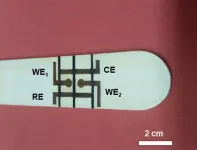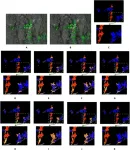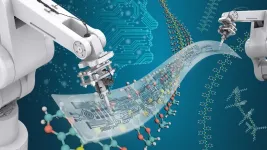(Press-News.org)
99% of the world's population breathes air that exceeds the limits recommended by the World Health Organization (WHO). This scenario is exacerbated in urban areas where more than 50% of the world's population is concentrated. To mitigate the problem of air pollution, considered by the WHO to be the main environmental risk factor for health worldwide, it is crucial to have more reliable and accurate data on the concentration of air pollutants in our cities, especially nitrogen dioxide (NO2) because of its harmful effects on people's quality of life and the associated economic consequences.
To advance in this line of research, a team of scientists from the Earth System Services group of the Earth Sciences Department at the Barcelona Supercomputing Center - Centro Nacional de Supercomputación (BSC-CNS) has carried out a study that shows that artificial intelligence can be of great use in obtaining reliable information on the probability of exceeding legal limits for air pollution throughout the city. The aim of the research, published in the journal Geoscientific Model Development, is to help improve air quality management in urban areas by obtaining hourly maps of NO2 concentrations at the street level, as well as quantifying the associated uncertainty.
The new method combines for the first time the results of CALIOPE-Urban, a unique model in Spain that allows air pollution forecasting at very high resolutions of up to ten metres, at different heights and at any point in the city, with an extensive urban database that includes observations from official air quality stations, low-cost sensor campaigns, information on building density, meteorological variables, and a long list of other geospatial information. In this way, areas of the city where the current monitoring system needs to be improved can be identified, helping to optimise strategies to reduce air pollution.
"The combination of CALIOPE-Urban predictions with all these urban data using artificial intelligence allows us to improve the model because where simulation cannot explain the spatial distribution of pollution, we can use machine learning to correct and improve this prediction," says Jan Mateu, leader of the BSC Air Quality Services team and one of the main authors of the study.
The use of machine learning techniques with observational data obtained during previous campaigns using passive dosimeters represents an important advance, as it reduces the inherent uncertainties associated with air quality models due to the low density of monitoring stations. This provides a better spatial characterisation of excess air pollution in different parts of the city.
One of the main conclusions of the study, which in this pilot phase focused on the city of Barcelona, is that the district with the worst air quality in the Catalan capital is the Eixample, where 95% of its area has more than a 50% probability of exceeding the annual average NO2 limit of 40 μg/m3 set by the European Commission (European Air Quality Directive 2008/50/EC).
"The Eixample district, the most populated district in Barcelona, is the most affected area in the city, as the vast majority of its surface area has a greater than 50% probability of exceeding the annual NO2 limit set by the European Commission. Thanks to our methodology, the public administration will be able to design and manage policies to improve air quality in urban areas, which is particularly important since air pollution is the main environmental risk factor for human health," adds Álvaro Criado, a researcher in BSC's Air Quality Services team and one of the main authors of the study.
The CALIOPE-Urban model
Developed at the BSC, CALIOPE-Urban is a modelling tool that estimates the concentration of nitrogen dioxide (NO2) at street level in the city of Barcelona, although it could also be applied to other cities or metropolitan areas. NO2 and its precursors are mainly emitted from combustion sources, such as vehicle engines, so monitoring is crucial to combat air pollution in large cities where traffic is often congested.
The system, which is unique in Spain, provides citizens and air quality managers with useful information on how traffic affects air pollution in each neighbourhood. This information is essential for designing and implementing effective planning and mitigation strategies to protect citizens from the health threats posed by air pollution. CALIOPE-Urban is currently focused on the city of Barcelona, but work is already underway to extend it to other municipalities in collaboration with various municipal and regional administrations.
CALIOPE-Urban combines the technology of the CALIOPE regional model, the BSC air quality prediction system, with an urban model that considers air pollution at street level, using information on traffic emissions and meteorological data. CALIOPE, the only air quality system that provides operational forecasts for Barcelona, Catalonia, the Iberian Peninsula and Europe, is the sole Spanish contributor to the European Union's Copernicus Atmosphere Monitoring Service (CAMS).
END
Humans and horses have enjoyed a strong working relationship for nearly 10,000 years — a partnership that transformed how food was produced, people were transported and even how wars were fought and won. Today, we look to horses for companionship, recreation and as teammates in competitive activities like racing, dressage and showing.
Can these age-old interactions between people and their horses teach us something about building robots designed to improve our lives? Researchers with the University of Florida say yes.
“There are no fundamental guiding principles ...
Doctors often use tongue depressors when peering in a patient’s mouth and throat. But what if that flat wooden spatula could actively evaluate the patient’s health? That’s the premise of an ecofriendly disposable sensor, reported in ACS’ Analytical Chemistry, that can check levels of glucose and other biomarkers in saliva. Researchers say the easy-to-produce device could someday help doctors assess a range of conditions.
Wood is a renewable, biodegradable, natural material that is widely available at low cost, which makes it attractive for researchers who design electronics and sensors. However, this is challenging because the material isn’t good ...
WHAT:
Children with multisystem inflammatory syndrome (MIS-C)—a rare condition linked with the virus that causes COVID-19—have biochemical indicators of cell injury and cell death that are distinct from other children with COVID-19, according to a study funded by the National Institutes of Health. Using high speed, artificial intelligence-controlled molecular sequencing of blood-and-plasma RNA and plasma DNA, researchers found that children with MIS-C have biomarkers indicating damage to multiple organs, the lining of blood vessels and the nervous system. MIS-C usually occurs two to six weeks after ...
LA JOLLA, CALIF. April 25, 2023 - With the help of a new grant from the U.S. Department of Defense for more than $1.7 million, Associate Professor Charles Spruck, Ph.D., will advance an innovative therapeutic approach for metastatic prostate cancer. Known as viral mimicry, the approach tricks the body into thinking that it has a viral infection, stimulating an immune response that can help the body fight cancer.
“In viral mimicry, the body thinks there’s an infection, which kicks the ...
Effective weed control is crucial in agriculture to ensure high crop productivity. It entails the careful separation of weeds from crops before herbicides are sprayed in the fields. In simple terms, the goal of weed control is to remove the weeds while ensuring that the crop are not harmed. Traditional weed control methods have several drawbacks, such as crop contamination, herbicide waste, and poor accuracy. Therefore, it is essential to develop methods that can precisely locate and identify the boundary between a crop and weed and implement ...
Researchers have a new scientific tool called Polybot, combining the power of artificial intelligence with robotics. Potential applications include speeding up the discovery of wearable biomedical devices, materials for better batteries and more.
Today’s wearable technologies like smart glasses and watches are just the start. The next generation of flexible electronics will be more efficient and sustainable, better able to monitor our health and treat certain diseases, and much more. They will be composed of electronic polymer materials — a soft pliable substance that can conduct electricity.
“Just imagine the next generation of polymer ...
New York (April 25, 2022) — The American Geriatrics Society (AGS) today announced Shelley R. McDonald, DO, PhD, MCG, as 2023 Clinician of the Year. Dr. McDonald, who is an Associate Professor of Internal Medicine at Duke University School of Medicine, will be honored at the 2023 AGS Annual Scientific Meeting (#AGS23) being held in Long Beach, CA, from May 4-6 (preconference day is May 3).
“Our 2023 Clinician of the year, Dr. Shelley McDonald, is a national champion for improved perioperative care of older adults undergoing surgery,” said ...
NEW YORK, April 25, 2023 ‒ Aetion®, the global leader in real-world evidence (RWE) technology and analytics, is pleased to announce the culmination of the RCT-DUPLICATE demonstration project, with complete findings published today in The Journal of the American Medical Association (JAMA). This three-year initiative tested whether researchers asking clinical questions in real-world data (RWD) — data from patients’ day-to-day interactions with the healthcare system — would obtain similar results to findings from randomized clinical trials (RCTs). In cases where clinical trial designs aligned with real patient care processes, the RWE studies and RCTs came ...
Consumption of cannabis (marijuana) or derivatives during pregnancy can cause respiratory problems for the baby, such as impaired control of breathing and diminished sensitivity to carbon dioxide, both of which favor sudden infant death syndrome. These are the main findings of a study conducted in Brazil and reported in an article published in the British Journal of Pharmacology.
The authors are researchers at São Paulo State University (UNESP) and the University of São Paulo (USP). They gave pregnant rats a synthetic compound (WIN 55) that acts on the brain in a similar manner to natural cannabinoids. Harmful effects occurred mainly in male pups.
“Cannabis ...
Investigators at Cedars-Sinai have created computer-generated models to bridge the gap between “test tube” data about neurons and the function of those cells in the living brain. Their study, published in the peer-reviewed journal Nature Communications, could help in the development of treatments for neurological diseases and disorders that target specific neuron types based on their roles.
“This work allows us to start looking at the brain like the complex machine that it is, rather than ...




